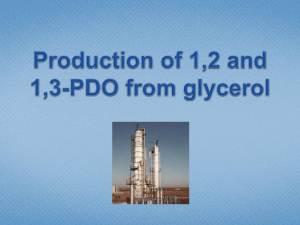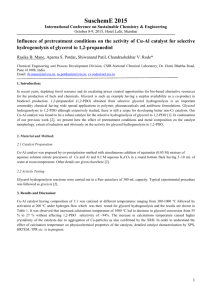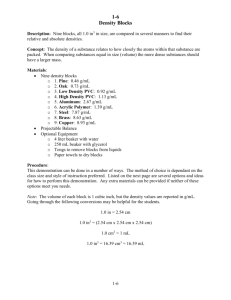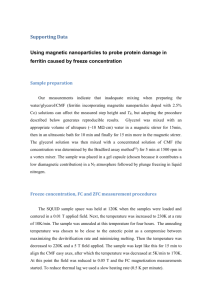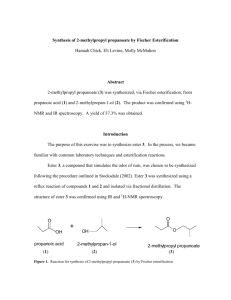prelimary study on the effects of palm methyl ester sulfonic acid
advertisement
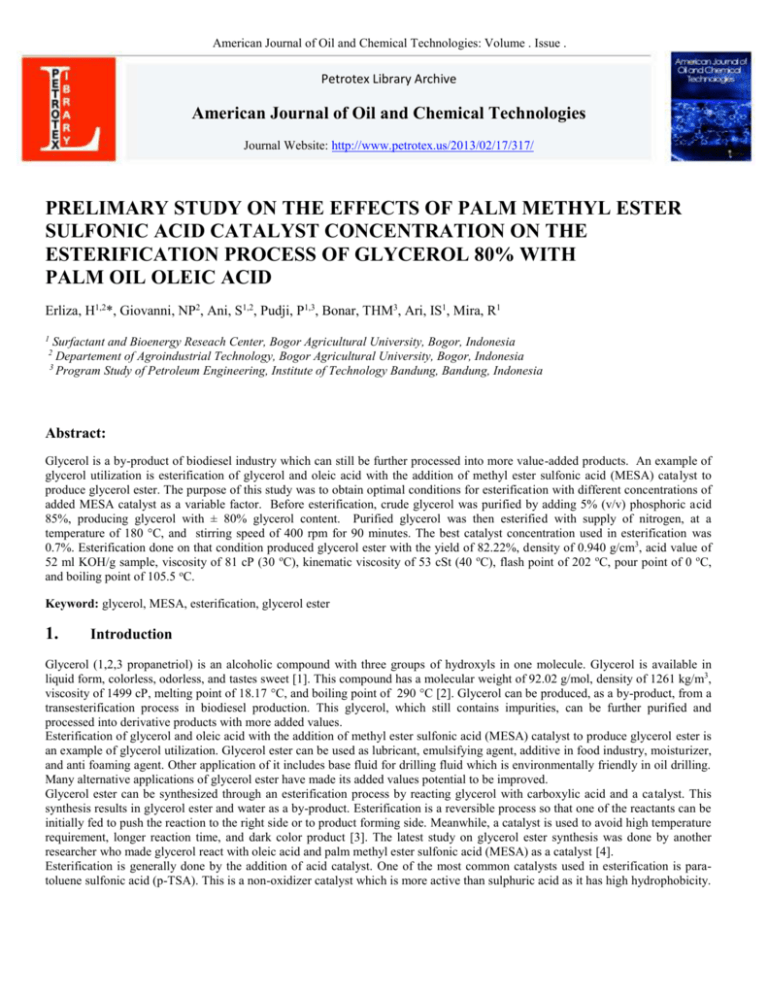
American Journal of Oil and Chemical Technologies: Volume . Issue . Petrotex Library Archive American Journal of Oil and Chemical Technologies Journal Website: http://www.petrotex.us/2013/02/17/317/ PRELIMARY STUDY ON THE EFFECTS OF PALM METHYL ESTER SULFONIC ACID CATALYST CONCENTRATION ON THE ESTERIFICATION PROCESS OF GLYCEROL 80% WITH PALM OIL OLEIC ACID Erliza, H1,2*, Giovanni, NP2, Ani, S1,2, Pudji, P1,3, Bonar, THM3, Ari, IS1, Mira, R1 1 Surfactant and Bioenergy Reseach Center, Bogor Agricultural University, Bogor, Indonesia Departement of Agroindustrial Technology, Bogor Agricultural University, Bogor, Indonesia 3 Program Study of Petroleum Engineering, Institute of Technology Bandung, Bandung, Indonesia 2 Abstract: Glycerol is a by-product of biodiesel industry which can still be further processed into more value-added products. An example of glycerol utilization is esterification of glycerol and oleic acid with the addition of methyl ester sulfonic acid (MESA) catalyst to produce glycerol ester. The purpose of this study was to obtain optimal conditions for esterification with different concentrations of added MESA catalyst as a variable factor. Before esterification, crude glycerol was purified by adding 5% (v/v) phosphoric acid 85%, producing glycerol with ± 80% glycerol content. Purified glycerol was then esterified with supply of nitrogen, at a temperature of 180 °C, and stirring speed of 400 rpm for 90 minutes. The best catalyst concentration used in esterification was 0.7%. Esterification done on that condition produced glycerol ester with the yield of 82.22%, density of 0.940 g/cm3, acid value of 52 ml KOH/g sample, viscosity of 81 cP (30 oC), kinematic viscosity of 53 cSt (40 oC), flash point of 202 oC, pour point of 0 oC, and boiling point of 105.5 oC. Keyword: glycerol, MESA, esterification, glycerol ester 1. Introduction Glycerol (1,2,3 propanetriol) is an alcoholic compound with three groups of hydroxyls in one molecule. Glycerol is available in liquid form, colorless, odorless, and tastes sweet [1]. This compound has a molecular weight of 92.02 g/mol, density of 1261 kg/m3, viscosity of 1499 cP, melting point of 18.17 °C, and boiling point of 290 °C [2]. Glycerol can be produced, as a by-product, from a transesterification process in biodiesel production. This glycerol, which still contains impurities, can be further purified and processed into derivative products with more added values. Esterification of glycerol and oleic acid with the addition of methyl ester sulfonic acid (MESA) catalyst to produce glycerol ester is an example of glycerol utilization. Glycerol ester can be used as lubricant, emulsifying agent, additive in food industry, moisturizer, and anti foaming agent. Other application of it includes base fluid for drilling fluid which is environmentally friendly in oil drilling. Many alternative applications of glycerol ester have made its added values potential to be improved. Glycerol ester can be synthesized through an esterification process by reacting glycerol with carboxylic acid and a catalyst. This synthesis results in glycerol ester and water as a by-product. Esterification is a reversible process so that one of the reactants can be initially fed to push the reaction to the right side or to product forming side. Meanwhile, a catalyst is used to avoid high temperature requirement, longer reaction time, and dark color product [3]. The latest study on glycerol ester synthesis was done by another researcher who made glycerol react with oleic acid and palm methyl ester sulfonic acid (MESA) as a catalyst [4]. Esterification is generally done by the addition of acid catalyst. One of the most common catalysts used in esterification is paratoluene sulfonic acid (p-TSA). This is a non-oxidizer catalyst which is more active than sulphuric acid as it has high hydrophobicity. Hambali et al. /American Journal of Oil and Chemical Technologies However, p-TSA is hazardous, corrosive, and made from fossil fuel which is non renewable natural resources [5]. Therefore, alternative new catalysts from renewable resources were required. Methyl ester sulfonic acid (MESA) is an intermediate compound obtained from the production of methyl ester sulfonic ester (MES) from palm oil. MESA can be used as a catalyst in esterification as it is acidic so that it can initiate an esterification process of glycerol and carboxylic acid. However, studies to determine the amount of MESA catalyst needed for an optimal glycerol esterification needed to be conducted. This study was aimed at obtaining the best condition for an esterification process of glycerol with a purity level of 80% and oleic acid with the addition of MESA catalyst. 1.1. Scope of the Study The scope of the study included: (1) glycerol sample used in this study was a by-product (glycerol 80%) of oil palm olein biodiesel industry, (2) MESA catalyst was palm methyl ester sulfonic acid, (3) glycerol ester synthesis was done through esterification of glycerol 80% and palm oil oleic acid under certain process conditions, (4) analysis of physicochemical properties, and (5) determination of the best esterification process condition. 2. Methods Purification of glycerol as a by-product of biodiesel production. Glycerol purification was done in a 20 L purification reactor by referring to a method used by Farobie [6]. First, crude glycerol, a by-product of biodiesel production, was placed in a purification tank to be heated until the temperature reached 50 °C. When the temperature was 50 °C, technical grade phosphoric acid 85% was added in by 5% (v/v). The temperature was then increased to 80°C followed by stirring for 4 hours. Heating and stirring were stopped and the solution was left for 30 minutes until three layers were formed. These layers (top to bottom) were fatty acid, purified glycerol, and salts. To separate glycerol from fatty acid, glycerol which was still mixed with salts was taken out from the purification tank. Glycerol was then separated from salts by using a filtration tool. 2.1. Esterification of purified glycerol In glycerol ester synthesis through esterification, purified glycerol was reacted with oleic acid with a molar ratio (glycerol:oleic acid) of 0.8:1 with the addition of MESA catalyst (w/w) by 0.3, 0.5, and 0.7%. Esterification was done in a triple neck boiling flask on a hot plate with a reaction temperature of 180 °C for 90 minutes. During the esterification process, 100 cc/minute nitrogen was flowed into the flask to avoid the existence of oxygen and push the water favor formed out to the condenser. 2.2. Analysis of glycerol, MESA catalyst, and glycerol ester Glycerol was analyzed for its content, viscosity (Brookfield DV-III ultra), and density (DMA 4500M Anton Paar). MESA catalyst was analyzed for its density (DMA 4500M Anton Paar), viscosity (Brookfield DV-III ultra), and pH. Glycerol ester was analyzed for its pH, acidic number, density (DMA 4500M Anton Paar), viscosity (Brookfield DV-III ultra), kinematic viscosity (ASTM D 445), boiling point (ASTM D 86), ignition point (ASTM D 92), and pouring point (ASTM D 97). 2.3. Data Analysis A factorial completely randomized design with two replicates was used. MESA catalyst concentration was used as the factor (A). The model of the experimental design was as follows. Yij = μ + Ai + εij (1) Where: Yijk = Observation value for the effect of A factor and i-level μ = Mean value Ai = Effect of MESA concentration of i-level (j=0.3, 0.5, 0.7%) εij = Error of experimental unit at i-level, factor A at j-replicate (j=1.2) Further, data were subjected to an analysis of variance and a Duncan test by using SPSS 16.0 application sofware. 2 Hambali et al. /American Journal of Oil and Chemical Technologies 3. Materials and Methods 3.1. Physicochemical Properties of Glycerol as a By-product of Biodiesel Industry Glycerol (1,2,3 propanetriol) is an alcoholic compound with three groups of hydroxyls in one molecule. Glycerol is available in liquid form, colorless, odorless, and tastes sweet [1]. This compound has a molecular weight of 92.02 g/mol [2]. Glycerol can be produced, as a by-product, from a transesterification process in biodiesel production. In a biodiesel industry, in addition to methyl ester, glycerol was resulted as a by-product by ±10% (Figure 1) [7]. As a by-product of biodiesel industry, glycerol can be further utilized after being purified. There are some impurities commonly found in glycerol [8]. These include methanol, catalyst (KOH/NaOH) remnants, soap, and water. Crude glycerol used in this study had a glycerol level of ± 50% and impurities including catalyst remnants, soap, and other impurities originating from biodiesel feedstock. Figure1. Chemical reaction in biodiesel formation Glycerol purification was done by referring to a method used by adding technical grade phosphoric acid 85% by 5% (v/v) to crude glycerol [6]. The acid would react with sodium hydroxide catalyst remnants to form potassium phosphate salt and separate free fatty acids. The remaining methanol remnants that did not react with acid would vaporize when glycerol was heated at 65°C. Figure2. Purified glycerol (left) and crude glycerol (right) Purification process changed the physicochemical properties of glycerol. These changes are shown in Table 1. Purification increased glycerol level, lowered viscosity and density, and brightened color. Purification separated other components making glycerol level increase. This increased value of glycerol level met the minimum level of glycerol namely 80% [9]. The lowered viscosity and density and increased boiling point showed that other impurities were already removed from crude glycerol. Brighter color indicated that catalyst remnants originating from methyl production which gave dark color effect was removed. Table1. Physicochemical properties of crude and purified glycerol Parameters Unit Crude glycerol Glycerol level Viscosity at 30°C % cP 45 ± 2. 05 625 ± 1. 07 Glycerol purified Pure in this study glycerol [2,10] 84 ± 2. 00 100 189 ± 0. 70 1499 Density at 25°C g/cm3 1.0745 ± 0.0001 1.2576 ± 0.0001 1. 261 Color Boiling point ° Blackish brown 80 ± 3.25 Brownish yellow 82 ± 2.05 Clear 290 C 3 Hambali et al. /American Journal of Oil and Chemical Technologies 3.2. Properties of Methyl Ester Sulfonic Acid Catalyst The use of a catalyst in a reaction is aimed at avoiding high temperature, relatively longer reaction time, and dark-colored product [3]. Esterification is commonly done by acid catalyst addition. One of the catalysts commonly used is para-toluene sulfonic acid (p-TSA). This catalyst is non oxidizer and more active than sulphuric acid as it has a high hydrophobicity. However, both PTSA and sulphuric acid are hazardous, corrosive, and originating from fossil fuel, a non renewable natural resource [5]. In order to overcome these drawbacks, MESA catalyst can be used as an alternative catalyst in esterification reaction. Figure3. MESA catalyst MESA is produced from palm oil, a renewable resource. MESA catalyst is a intermediate compound produced in the production of methyl ester sulphonate (MES) surfactant. Sulphonation reaction of methyl ester results in a by-product, methyl ester sulfonic acid, which is dark in color and acidic (Figure 3). The properties of MESA used in this study are given in Table 2. Table2. Physicochemical properties of MESA catalyst Parameter pH (1% in distilled water) Density at 25°C Color Unit g/cm3 Value 2.2 0.9173 ±0.0001 Black Based on its pH, MESA is highly acidic. This is the basis for MESA catalyst utilization in esterification. The acidity of MESA, like in other catalysts, is suggested to create protonization of oleic acid which is the initiation of ester forming process. 3.3. Results of Ester Glycerol Analysis Esterification is a formation of ester by reacting fatty acid with alcohol. Glycerol ester is an ester with glycerol as its alcohol molecule. Esterification of glycerol and oleic acid resulted in glycerol monooleic, dioleic, or trioleic [11]. This reaction is shown in Figure 4. Figure4. Reaction of glycerol ester formation 4 Hambali et al. /American Journal of Oil and Chemical Technologies In this study, after esterification, two layers were formed. The top layer was glycerol ester and the bottom one was the remaining glycerol that did not react. The glycerol ester in this study was a mixture of monooleic, dioleic, and trioleic glycerol and the remaining fatty acids that did not react. This product of esterification is shown in Figure 5. Figure5. Result of glycerol and oleic acid esterification The formation of two layers was caused by the finding that there was still some glycerol that did not react until the end of reaction period. Feeding more oleic acid reactant than glycerol was done to push the reaction to the direction of product formation. Esterification reaction is a reversible reaction which needs to be done in such a way that that it makes the reaction move to product formation direction. In order to get an optimal product, the esterification reaction balance has to be moved to the right side or product formation direction by supplying energy into the reaction, feeding excessive reactant, and continuous taking the reaction product out during the process period [12]. In this study, effort was done to push reaction to the right side by feeding excessive reactant. In addition, during the esterification process, nitrogen gas was flowed continuously to push water favor, a by-product of esterification, out of the reactor so that product could be obtained optimally. If it is not removed out of the reactor, the formed water favor can hydrolyze glycerol ester back to glycerol and oleic acid. Right after glycerol esterification was done, the yield of glycerol ester was measured. Then, the properties of glycerol ester were assessed through the determination of acidic number, density, viscosity, kinematic density, ignition point, pouring point, and boiling point. 3.3.1. Yield In this study, yield was the amount of glycerol reacted with oleic acid to produce glycerol ester. In Figure 6, it is shown that increasing the concentration of MESA catalyst increased yield. This might be caused by the fact that the addition of catalyst increased the effectiveness of the esterification reaction so that the conversion of reactant into glycerol ester increased. Yield (%) 85 82.22 79.55 80 75.33 75 70 0,3 0,5 0,7 MESA catalyst addition (%) Figure6. Effect of MESA catalyst concentration on glycerol ester yield Based on the results of ANOVA and Duncan test, it was found that catalyst concentration significantly affected the yield of glycerol ester. The highest yield was obtained in MESA catalyst addition by 0.7%. 3.3.2. pH Glycerol ester sample yielded from the esterification was a mixture of monooleic glycerol, dioleic glycerol, trioleic glycerol, remaining oleic acid that did not react, and MESA catalyst. pH measurement was taken by diluting glycerol ester in distilled water by 30%. In water, glycerol ester sample did not dissolve but the MESA used did. pH measurement was taken to determine the 5 Hambali et al. /American Journal of Oil and Chemical Technologies amount of MESA catalyst found in the esterification product. Higher pH indicated higher amount of MESA catalyst in glycerol ester. Results of this pH measurement are shown in Figure 7. 8.0 pH 6.0 5.46 5.28 5.17 0,3 0,5 0,7 4.0 2.0 0.0 MESA catalyst addition (%) Figure7. Effect of MESA catalyst concentration on pH It was shown in Figure 7 that higher concentration of MESA catalyst increased pH values. MESA had low pH so that more MESA catalyst added resulted in higher amount of MESA left in glycerol ester which in turn lowered pH values. 3.3.3. Density Density (g/cm3) Density or specific weight is the weight per unit volume of a material. Density was measured to assess the dense of molecules in resulted glycerol ester. It was shown in Figure 8 that higher catalyst concentration increased the density of glycerol ester. The density of ester of carboxylic fatty acid was affected by molecular weight and temperature. Higher molecular weight meant higher density [13]. 1.5 1.2 0.9 0.6 0.3 0.0 0.938 0.940 0.940 0,3 0,5 0,7 MESA catalyst addition (%) Figure8. Effect of MESA catalyst concentration on glycerol ester density It was shown in Figure 8 that higher concentration of MESA catalyst increased glycerol ester density. This might be caused by the fact that increased level of catalyst improved the effectiveness of esterification allowing more oleic acid to bind glycerol and the formed ester molecules to have heavier molecular weight. In addition, the existence of MESA catalyst in higher amount in final product affected the specific weight of that product. However, this effect was not significant as MESA itself had lower density than glycerol ester did. It was also found that MESA catalyst addition did not significantly affect density values. This might be caused by the finding that each sample of esterification product contained similar main components, namely monooleic glycerol, dioleic glycerol, and trioleic glycerol making the density of each sample not too different. 3.3.4. Acidic number Acidic number indicates the amount of KOH (ml) needed to neutralize 1 gram of fat/oil. Acidic number is used to determine the amount of free fatty acid per gram sample. This means that higher acidic number indicates higher fatty acid content. 6 Acidic number (ml KOH/g sample Hambali et al. /American Journal of Oil and Chemical Technologies 80 60 39 44 0,3 0,5 40 52 20 0 0,7 MESA catalyst addition (%) Figure9. Effect of MESA catalyst concentration on acidic number of glycerol ester It was shown in Figure 9 that increased catalyst concentration increased the acidic number of glycerol ester. More catalyst added meant more effective esterification process. However, excess catalyst might inhibit the esterification process. Excess use of catalyst resulted in higher remains of catalyst found in the esterification product. This excess MESA increased acidic number. It was also found that catalyst concentration gave significant effect on acidic number. Results showed that no different acidic number was found with the addition of catalyst by 0.3 to 0.5%. Significant differences in acidic numbers were found with the addition of catalyst by between 0.3 to 0.7% and 0.5 to 0.7%. 3.3.5. Viscosity Viscosity is a physicochemical property indicating the thickness level of a fluid. Increased viscosity is caused by an increase in molecule concentration [14]. It may also be caused by an increase in chain length and molecular weight of a material. Viscosity affects the flow characteristic of a fluid. A fluid with higher viscosity has a lower ability to flow. It was shown in Figure 10 that higher use of MESA catalyst pushed the esterification reaction to the direction of ester production. This lowered viscosity level as glycerol with high viscosity level would bind oleic acid making the final product contain less glycerol. As shown in Figure 10. Glycerol ester with MESA catalyst addition of 0.7% had the lowest viscosity. This indicated that glycerol ester was mostly formed with the use of MESA by 0.7%. Viscosity (cP) 120 92 90 0,3 0,5 90 81 60 30 0 0,7 MESA catalyst addition (%) Figure10. Effect of MESA catalyst concentration on viscosity of glycerol ester It was also found that catalyst concentration gave significant effect on viscosity levels of glycerol ester. Results showed that all levels of catalyst addition (0.3, 0.5, and 0.7%) gave significant effects on viscosity. 3.3.6. Kinematic viscosity Kinematic viscosity is a test to measure the flow resistance level of glycerol ester. Higher kinematic viscosity means that it is more difficult for the fluid to flow. Viscosity level is affected by carbon chain length and position and number of double bonds of the fatty acids or alcohol used in ester synthesis [15]. Longer carbon chain increases kinematic viscosity while the existence of double bonds lowers it. Kinematic viscosity is a function of dynamic viscosity and density [16]. Higher dynamic viscosity and lower density increases kinematic viscosity level. 7 Hambali et al. /American Journal of Oil and Chemical Technologies Viskositas kinematis (cSt) It was shown in Figure 11 that the lowest kinematic viscosity was found with MESA addition by 0.7%. Like the phenomenon found in viscosity parameter, higher use of MESA catalyst pushed the esterification reaction to the direction of ester production. This lowered viscosity level as glycerol with high viscosity level would bind oleic acid making the final product contain less glycerol. It was found that MESA catalyst concentration did not give any significant effect on kinematic viscosity of resulted glycerol ester. As discussed previously, esterification of glycerol and oleic acid results in monooleic, dioleic, or trioleic glycerol with one of them as the dominant component which affects the general physicochemical property of glycerol ester. In this study, the no differences found in kinematic viscosity indicated that all samples had main components in more or less similar concentration. 80 60 40 20 0 53 49 43 0,3 0,5 0,7 Penambahan katalis MESA (%) Figure11. Effect of MESA catalyst concentration on kinematic viscosity of glycerol ester One of the applications of glycerol ester is the use of it as basic material in the production of synthetic-based drilling fluid (SBF). SBF drilling mud with glycerol ester as its basic material has a performance which is as good as oil-based drilling fluid’s (OBF), yet it is more environmentally friendly. The application of glycerol ester as a base fluid in drilling fluid can be done as long as the physicochemical properties of it meet the base oil requirements. Kinematic viscosity is a rheology parameter a material has to have when it is to be used as a base fluid material in a drilling fluid. Saraline and Sarapar are two examples of commercial base fluid used in SBF production with their respective kinematic viscosity of 3-4 and 2.5 cSt. Another commercial synthetic fluid has a kinematic viscosity of 4.5 cSt. Therefore, the expected kinematic viscosity in this study was the lowest which was obtained by the addition of MESA catalyst by 0.7%. 3.3.7. Ignition point Ignition point (oC) Ignition point is the lo west temperature at which a material can ignite fire and then burn itself [17]. Ignition point is a parameter affected by light fraction content (alcohol residue). Higher content of light fraction in an ester makes it need lower temperature to ignite [18]. A material with low ignition point is easier to burn so that this kind of material needs special handling and storage. It is shown in Figure 12 that glycerol ester with the highest ignition point was the one produced with MESA catalyst addition by 0.5%. This meant that esterification done with 0.5% MESA catalyst resulted in glycerol ester containing small remains of fatty acids and glycerol. In esterification, as an alcohol, glycerol releases its hydroxyl groups and binds oleic acid to form ester. This makes the ignition point of glycerol ester higher. Purified glycerol has an ignition point of 120 °C and oleic acid 180 °C. Lowered ignition point of glycerol ester with the addition of MESA catalyst 0.7% might be caused by significant amount of glycerol and oleic acid remains in glycerol ester. These remaining glycerol and oleic acid were suspected to not completely react during the esterification process. 250 204 206 202 200 150 100 50 0 0,3 0,5 0,7 MESA catalyst addition (%) Figure12. Effect of MESA catalyst concentration on ignition point of glycerol ester 8 Hambali et al. /American Journal of Oil and Chemical Technologies It was found that catalyst concentration did not give significant effect on ignition point. Relatively similar component composition in each esterification product sample made the ignition points which were not different. Ignition point is also used as a consideration in the utilization of glycerol ester as a base fluid in a drilling fluid. Commercial base fluid is required to have a minimum ignition point of 90 °C. Compared to this commercial base fluid, glycerol ester produced in this study had higher ignition point. A material with higher ignition point is better and easier to handle when the material is burned out. 3.3.8. Pouring point Pouring point is the lowest temperature at which a material is still able to flow [19]. A material with lower pouring point still flows at lower temperature. The length of chain and degree of unsaturation of a molecule affect its pouring point, longer molecular chain increases pouring point while double bonds indicating unsaturation decreases pouring point [20]. In addition to kinematic viscosity and ignition point, pouring point of is used as a parameter to consider when a material is to be applied as a base fluid. It is shown in Figure 13 that the pouring point of glycerol ester in general is 0 °C. This means that at temperature under 0 °C, there will be a formation of white crystals in glycerol ester and this glycerol ester no longer flows. With MESA catalyst addition by 0.5%, the pouring point of glycerol ester dropped to its lowest point of -1.5 °C. Pouring point (oC) 5.0 2.5 0.0 0.0 0.0 -1.5 -2.5 -5.0 0,3 0,5 0,7 MESA catalyst addition (%) Figure13. Effect of MESA catalyst concentration on pouring point of glycerol ester A material or fluid with low pouring point is better to use in areas with low temperature. In this study, it was found that catalyst concentration did not give significant effect (α=5%) on the pouring point of glycerol ester produced. This showed that all samples of glycerol ester had similar composition. It is shown in Figure 13 that esterification done with the addition of 0.5% catalyst resulted in optimal product with more oleic acid getting bound to glycerol. Double bonds in oleic acid affected the pouring point of the glycerol ester formed. Therefore, more oleic acid getting bound to glycerol produced glycerol ester with lower pouring point. The pouring point of Saraline and Sarapan are -16 °C and -11 °C, respectively. Other commercial base oil requires a pouring point below 18 °C. Although its pouring point (1.5 °C) was not as low as those of Saraline and Sarapar, glycerol ester produced in this study still met the requirements to be used as a base fluid in a drilling fluid. 3.3.9. Boiling point Boiling point is a physicochemical property showing a temperature at which a material starts boiling. Boiling point shows a strong intermolecular force in a fluid. Higher intermolecular force increases boiling point. Boiling point is affected by molecular weight and hydrogen bond [21]. In Figure 14, it was shown that higher MESA catalyst concentration increased boiling point. This was caused by the finding that catalyst addition increased esterification effectiveness that also meant more glycerol ester formed. 9 Boiling point (oC) Hambali et al. /American Journal of Oil and Chemical Technologies 120 104.5 105.0 105.5 0,3 0,5 0,7 90 60 30 0 MESA catalyst addition (%) Figure14. Effect of MESA catalyst concentration on boiling point of glycerol ester It was also shown that catalyst concentration did not significantly (α=5%) affect the boiling point of glycerol ester produced. Samples of glycerol ester with relatively similar compositions had resulted in a mixture with relative similar molecular weight. This might be the cause of similar boiling point of glycerol ester produced in this study. In the production of base fluid for a drilling fluid, boiling point is also observed to avoid the application of a base fluid in a drilling condition with a temperature higher than the boiling point of the base fluid. Saraline starts boiling at 200 °C. Other commercial base fluids are required to have minimum boiling point of 200 °C. Therefore, based on its boiling point, glycerol ester produced in this study did not yet meet the specification required for a base fluid in a drilling fluid. After the physicochemical properties of glycerol ester were analyzed, the best esterification was determined based on the analyzed parameters. First, the highest yield of glycerol ester was obtained from esterification condition with the addition of 0.7% META catalyst. For density, there no significant effect of catalyst concentration was found. In addition, the difference in density levels was small so that the selection of the best esterification condition was based on the other parameters. Meanwhile, the lowest acidic number was obtained from the esterification with 0.3% MESA catalyst. However, high acidic number might be also caused by the existence of MESA in the glycerol ester, the final product. Next was viscosity parameter. The best glycerol ester was the one with the lowest viscosity. This was obtained from the esterification done with 0.7% MESA catalyst. The lowest kinematic viscosity in glycerol ester was also used to determine the best esterification condition. This was used as low viscosity meant easier flow. In this study, the lowest kinematic viscosity was shown by glycerol ester resulted from the esterification process done with 0.7% MESA catalyst. With regard to ignition point, the best esterification process was the one resulting in glycerol ester with the highest ignition point. A material with high ignition point is easier to handle as it is more difficult to get burned. The highest ignition point was given by glycerol ester resulted from the esterification process done with 0.5% MESA catalyst. However, when it is applied as a base oil in a drilling fluid, an ignition point of 202 °C meets the standard requirement. The lowest pouring point was shown by glycerol ester resulted from the esterification process done with 0.5% MESA catalyst. Lower pouring point makes a material flow in low temperature. However, a pouring point of 0 °C is adequate for a material to meet the requirement for being applied as a base oil. Finally, glycerol ester with the highest boiling point was the one resulted from the esterification process done with 0.7% MESA catalyst. Overall, the best esterification condition was the one done with 0.7% MESA catalyst. 4. Conclusions and Recommendations 4.1. Conclusions MESA catalyst could be used in the esterification of glycerol and oleic acid. The addition of MESA catalyst improved the reaction effectiveness of esterification so that more glycerol ester was produced. The best esterification process condition was the one done with 0.7% MESA catalyst producing glycerol ester which had 82.22% yield, 0.940 g/cm3 density, 52 ml KOH/g sample acidic number, 81 cP (30 °C) viscosity, 53 cSt (40 °C) kinematic viscosity, 202 °C ignition point, 0 °C pouring point, and 105.5 °C boiling point. 4.2. Recommendations Further studies on esterification process of glycerol with higher purity levels to produce glycerol ester having all parameters met the requirements for base oil application in drilling fluid were recommended. 10 Hambali et al. /American Journal of Oil and Chemical Technologies 4.3. Accnowledgment The authors wish to thank Lembaga Pengelola Dana Pendidikan (LPDP) for the financial support of the research work reported in this paper. 5. References [1] M.L. Eastridge, Feeding glycerol to cows has limits, Farm and Dairy Online, 2007. [2] M. Pagliaro, M. Rossi, “The Future of Glycerol New Uses Of a Versatile Raw Material”, The Royal Society of Chemistry, 2006 [3] Y.H. Hui, Bailey Industrial Oil and Fat Products, Volume 1, J Wiley, New York (US), 1995 [4] A. Utami, Effect of catalyst concentration of sulfonic acid methyl ester to the physicochemical properties of the resulting glycerol ester of oleic, Bogor Agricultural University, Bogor, 2013 [5] S. Kale, U. Armbruster, S. Umbarkar, M. Dongare, and A. Martin, Esterification of glycerol with acetic acid for improved production of triacetin using toluene as an entrainer, Green Chemistry Conference 10th, 2013 [6] O. Farobie, Utilization of glycerol byproduct of biodiesel production as auxiliary material cement crusher [thesis], Bogor Agricultural University, Bogor, 2009 [7] G. Knothe, J. Van Gerpen, and J. Krahl, The Biodiesel Handbook, AOCS Press, Illinois, 2005 [8] M.L. Eastridge, “Variation in the chemical composition of crude glycerin” Animal Sciences, 2009 [9] Indonesian National Standard, Gliserol Kasar, Indonesian National Standard , JakartaI, 1995 [10] J.B. Segur, H.E. Oberstar, Viscosity of glycerol and its aqueous solutions, Journal of Industrial and Engineering Chemistry, 43, 2177-2120, 1951 [11] Pardi, Optimization of the production process of glycerol monooleate of glycerol as byproduct of biodiesel production [thesis]. Noth Sumatera University, Medan, 2005 [12] R.J. Fessenden, J.S. Fessenden, Organic Chemistry, Vol. 2, third Ed., Erlangga, Jakarta, 1982 [13] J.C. Phillips, G.J. Mattamal, Effect of number of carboxyl gropus on liquid density of esters of alkylcarboxylic acids, Journal of Chemical and Engineering Data, 23, 1-6, 1978 [14] K. Holemberg, B. Jonsson, B. Kronberg, and B. Lindman, Surfactants and Polymers in Aqueos Solution, Jhon Wiley & Sons, Ltd., London (GB), 2002 [15] K. Gerhard, K.R. Steidley, “Kinematic viscosity of fatty acid methyl esters: Prediction, calculated viscosity contribution of esters with unavailable data, and carbon–oxygen equivalents”, Journal of Fuel and Energy Science and Technology, 84, 3217–3224, 2011 [16] J.C.C. Hernandez, D.E.P. Catalan, Predicting the kinematic viscosity of FAMEs and biodiesel: empirical models. Journal of Fuel and Energy Science and Technology, 7844: 09, 2014 [17] American Society for Testing and Materials, Standard Test Methods for Flash Point by Pensky-Martens Closed Cup Tester, ASTM International, West Conshohocken, 2005 [18] Mittelbach M, Remschmidt C, Biodiesel: the Comprehensive Handbook, 330, ISBN: 3-200-00249-2, 2004 [19] American Society for Testing and Materials, Standard Test Methods for Pour Point of Petroleum Products, ASTM International, West Conshohocken, 2009 [20] Jr. N.U. Soriano, V.P. Migo, M. Matsumura, Ozonized vegetable oil as pour point depressant for neat biodiesel, Journal of Fuel and Energy Science and Technology, 85, 25-31, 2006 [21] C.R. Kinney, A system corelating molecular structure of organic compounds with their boiling points, Journal of Organic Chemistry, 06, 220-228, 1941 11

